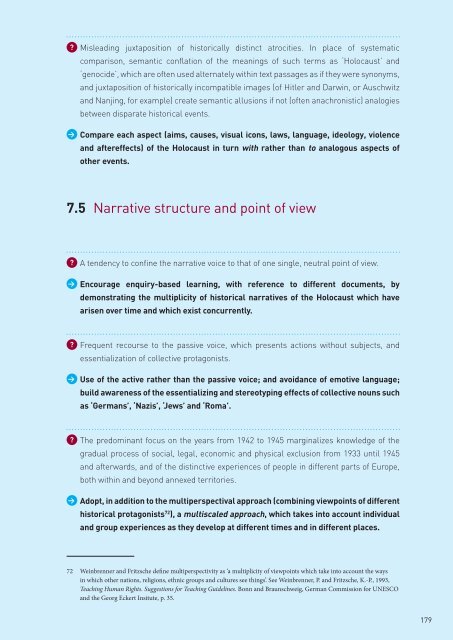228776e
228776e
228776e
Create successful ePaper yourself
Turn your PDF publications into a flip-book with our unique Google optimized e-Paper software.
Misleading juxtaposition of historically distinct atrocities. In place of systematic<br />
comparison, semantic conflation of the meanings of such terms as ‘Holocaust’ and<br />
‘genocide’, which are often used alternately within text passages as if they were synonyms,<br />
and juxtaposition of historically incompatible images (of Hitler and Darwin, or Auschwitz<br />
and Nanjing, for example) create semantic allusions if not (often anachronistic) analogies<br />
between disparate historical events.<br />
> Compare each aspect (aims, causes, visual icons, laws, language, ideology, violence<br />
and aftereffects) of the Holocaust in turn with rather than to analogous aspects of<br />
other events.<br />
7.5 Narrative structure and point of view<br />
A tendency to confine the narrative voice to that of one single, neutral point of view.<br />
> Encourage enquiry-based learning, with reference to different documents, by<br />
demonstrating the multiplicity of historical narratives of the Holocaust which have<br />
arisen over time and which exist concurrently.<br />
Frequent recourse to the passive voice, which presents actions without subjects, and<br />
essentialization of collective protagonists.<br />
> Use of the active rather than the passive voice; and avoidance of emotive language;<br />
build awareness of the essentializing and stereotyping effects of collective nouns such<br />
as ‘Germans’, ‘Nazis’, ‘Jews’ and ‘Roma’.<br />
The predominant focus on the years from 1942 to 1945 marginalizes knowledge of the<br />
gradual process of social, legal, economic and physical exclusion from 1933 until 1945<br />
and afterwards, and of the distinctive experiences of people in different parts of Europe,<br />
both within and beyond annexed territories.<br />
> Adopt, in addition to the multiperspectival approach (combining viewpoints of different<br />
historical protagonists 72 ), a multiscaled approach, which takes into account individual<br />
and group experiences as they develop at different times and in different places.<br />
72 Weinbrenner and Fritzsche define multiperspectivity as ‘a multiplicity of viewpoints which take into account the ways<br />
in which other nations, religions, ethnic groups and cultures see things’. See Weinbrenner, P. and Fritzsche, K.-P., 1993,<br />
Teaching Human Rights. Suggestions for Teaching Guidelines. Bonn and Braunschweig, German Commission for UNESCO<br />
and the Georg Eckert Insitute, p. 35.<br />
179




